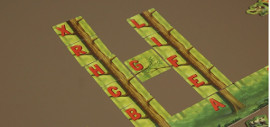Alphabet Woods helps children practice alphabetical order, making it fun rather than drudgery. This game is very unusual. You start play with the 2.75” tall forest floor board that has the beginnings of five tree trunks and the letter “A” at the base of each tree. (The game uses only upper-case letters.) Players have seven letter cards in their hands. They try to play as many of their cards as they can each turn, building up from the five “A’s” at the bottom. They can skip letters, but cards must still be in alphabetical order. For example, a player might play the letters C, F, and M on one tree in that order. Seven letters makes a complete tree. Five tree top cards can be played to show that a tree is complete.
Since there are 93 letter cards, there are other ways to play those cards. They can be played on top of previously-played letter cards as long as it keeps things in alphabetical order. Nineteen of the cards are branch cards that can be played between two trees if they can match the alphabetical order of both trees. With younger players, you might pull out the branch cards since that’s an added layer of difficulty. For every card played, players collect a forest animal icon of their choosing. The player who collects the most animals wins.
As with other SimplyFun games, the game components are both beautiful and sturdy. Even the animal icons are printed on both sides of super-dense 1/16” cardboard that is very unlikely to bend or break.
The publisher says that this game is for ages five and up, but a child needs to be very familiar with the alphabet or else they will get frustrated figuring out what they can play. This game helps children develop facility with alphabetical order, but it isn’t intended for helping them learn the alphabet. I think it is probably best for children about six to nine years old. You can still include a younger child by partnering them with an older child or adult to assist them. From two to five players can play at one time.
I think Alphabet Woods is a great game, but it does target a very narrow skill. Game elements and chance make it fun, but it isn’t likely to be the sort of game that will be played for many years. That makes it a practical purchase for group classes or for families with at least a few children who will benefit from practicing their alphabetizing skills with this game or who are still young enough to enjoy it.









